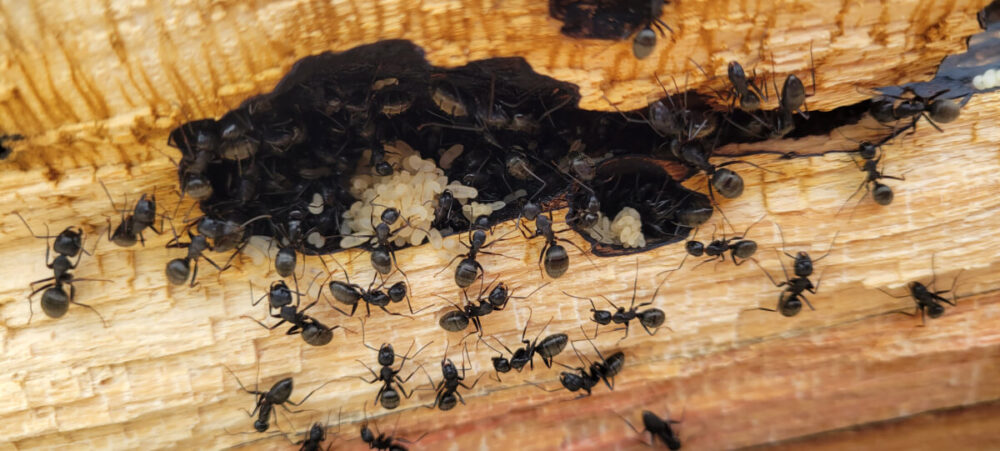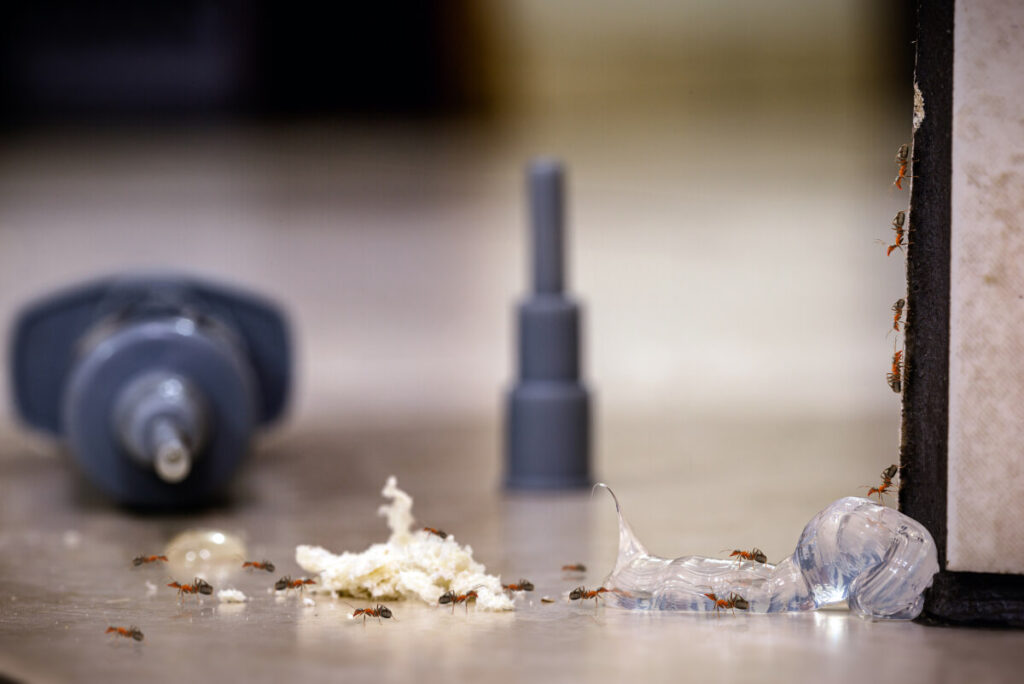
When you see big black ants running on your floors or kitchen counters, it can be an obvious sign that you have an active colony of carpenter ants in your home. While this ant species primarily dwells outdoors in tree stumps, logs, and other decayed wood, they can also establish their nests inside your walls if they find an opening in your exterior foundation, windows, or basements.
So how can you confirm that you have carpenter ant nests within your walls? The most evident sign is when you see active carpenter ant trails on your walls. You may also notice a sudden appearance of ants when you bump or tap on your walls. Other signs of carpenter ant infestation in walls include hearing a hollow sound on wood, rustling noises coming from the walls, and piles of wood shavings.
Carpenter ants fall into the same category as termites in terms of the structural damage that they cause. The only way you can distinguish carpenter ants from termites is that they don’t consume wood. Instead, these ants burrow create galleries in wood to establish their nests and this excavation can significantly weaken wooden structures.
Most of the time, homeowners don’t know that they have an existing carpenter ant problem until they see extensive damage. One reason for this is that carpenter ant workers remain hidden during the day and only come out in search of food in the evening. It’s also hard to locate their indoor nests, especially without the help of a pest control professional.
They create their nests deep within the wood in hollow spaces, wall voids, attics, and gaps in windows and door frames. In some cases, you might need to break open a section of the wood or drill a hole in the wall to confirm the presence of a carpenter ant colony.
Although carpenter ants are excellent at staying out of sight within your walls, they can’t entirely go unnoticed. Like most pest insects, they have distinct behaviors and signs that can confirm their activity in your home. Here are some of the warning signs that you have carpenter ants in your walls:
The most convincing sign of indoor carpenter ant infestation is seeing a large number of ants in every corner of your home. A worker ant rarely travels alone, especially when they’re looking for a potential food source. It’s not uncommon to see carpenter ants trailing after one another as they follow their scent trails to their food. If you notice a long line of black ants, you can follow their trail to see where they’re coming from as it’s likely the location of their indoor nest.
Most of the time, carpenter ants won’t show themselves in broad daylight and they much prefer to hide in their nests within your walls. But like any household pests, they’ll come out of hiding when they’re disturbed. If you bump or knock into a wall, the sudden sounds and vibrations will cause carpenter ants to evacuate and you’ll suddenly see a group of ants emerging from their access points in the walls.
Carpenter ants can’t do as much damage to wood as the termite pests do but they are still known as a threat to any structures. While they’re specifically drawn to moist and water-damaged wood, they can also build their satellite colonies within healthy wood. As they excavate the wood for their nesting site, they can destroy the structural components of the walls and you can confirm this by tapping on the surface and hearing a hollow sound.
There are several types of pests that can make an audible sound when they’re moving inside your walls and one of those is the carpenter ant. When the major workers of the colony are chewing through the wood in the walls, you can hear a rustling sound that’s similar to the crinkling of cellophane. These noises are more recognizable during the night when they’re actively foraging for food.
Since carpenter ants don’t digest wood, they’ll push out the shavings that have accumulated as a result of their excavation. These fragments of wood typically resemble coarse sawdust or small round pellets. Carpenter ants usually push out these pellets outside their kick-out holes and you’ll likely see them compiled along baseboards or hollow doors. You may also see dead insects and other wood debris pushed out by carpenter ants from the holes.
There are specific species of ants that emit a distinct smell when they die. For carpenter ants, they release formic acid which has a strange aroma that smells like rotten coconut. You’ll notice this smell when you crush a visible carpenter ant or sometimes, there are ants that die in the parent colony which creates the foul odor that lingers within your walls.

Carpenter ants typically live outdoors but they can travel to your home if they find that you have an abundant source of food and moisture. Mature colonies of carpenter ants may also send out winged reproductives to expand their population and look for new nesting sites indoors.
Because they’re extremely small, carpenter ants can easily fit into any tiny opening, crevice, and cracks around the foundation, windows, or through crawl spaces, ventilation, and air-conditioning ducts. They can also find access to your house through structural beams, ceilings, roofs, and any wood material that’s in contact with soil. Additionally, they can travel through tree limbs or utility lines that are touching the exterior walls of your house.
The carpenter ants aren’t the only species that can start an indoor infestation. Here are the other common types of household ants that can live within your walls:
Dealing with carpenter ants can be challenging but once you know their nesting space, controlling and exterminating them will be easy. Here are some of the ways you can eliminate carpenter ants within your walls:
Baiting is an effective method of ant control that can get rid of their entire colony. Carpenter ant baits typically contain an active ingredient, such as boric acid, mixed with a food component that will attract the workers. The idea behind baiting is that the worker ants will take the toxic bait to their colony and feed it to the queen ants. By killing the egg-laying queens, the colony will stop reproducing and the other ants in the nest will eventually die.
Once you’ve identified the locations of their nests, you can use insecticide sprays to get rid of them from your walls. You can directly apply the liquid insecticide on their entry points and kill them on contact or use the non-repellent sprays which have a slow-acting effect on the ants but can ensure the elimination of the colony. Additionally, you can opt to put residual insecticide dusts around their nests as well in order to control their activity and kill the ants that come in contact with it.
After applying the appropriate treatments, it’s also a smart move to close all possible entry points that carpenter ants use to access your home. Inspect your walls for any holes and seal them immediately. You should also remove water-damaged or rotten wood and fix water leaks to remove moisture sources for the ants.
You should also treat your outdoor living space since most ants are coming from the outside. Check the tree stumps, logs, woodpiles in your garden for any sign of carpenter ant nest and activity. If you find their colony, you can eliminate them by applying diatomaceous earth directly to their nest or spreading them within the perimeter of your home to act as a barrier against the ants.

An indoor carpenter ant infestation can be alarming, especially since they can cause potential damage if they’re already present in large numbers in your home. With Yale Pest Control, our team of experts can help track their location and get rid of them within your walls.
Yale Pest Control is a professional pest control company offering comprehensive pest management solutions and preventive control measures. Our pest control technicians are experienced in treating all kinds of household pests including ants, termites, rodents, bed bugs, and spiders. If you want to free your house from carpenter ants, call us today and schedule a home inspection.